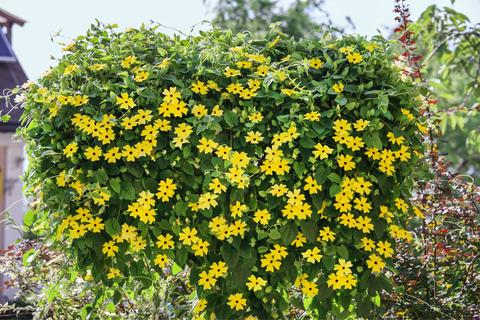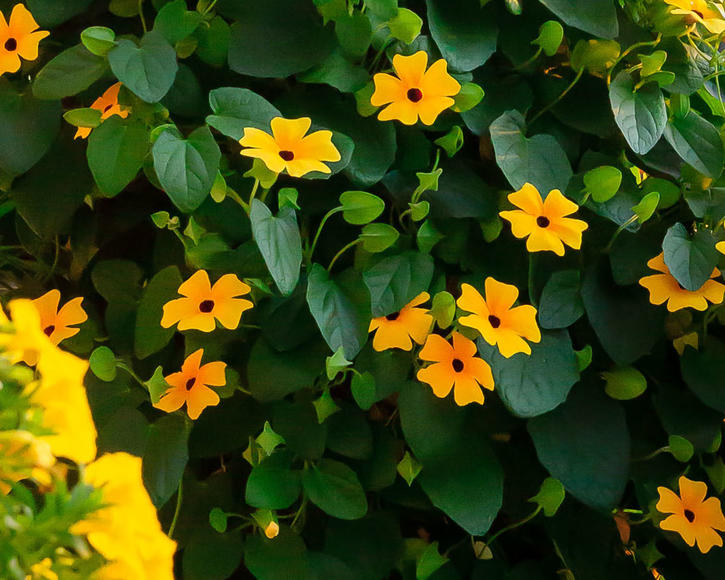Black-Eyed Susan Vine
With its fine flowers and dark central spots, the black-eyed Susan vine is a popular annual climber for gardens, balconies and patios. You’ll find tips on sowing and caring for this plant here, as well as recommended varieties.
Factsheet
- Growth type
-
- Climber
- one year old
- Growth height (from)
- from 120 cm to 150 cm
- Growth width (from)
- from 0 cm to 0 cm
- Flower color
-
- yellow
- orange
- white
- multicolored
- Flowering time (month)
-
- June to October
- Flower shape
-
- Uniflorous
- Funnel
- Leaf color
-
- green
- page format
-
- ovate
- Light
-
- sunny
- Soil type
-
- sandy to loamy
- Soil Moisture
-
- moderately dry to fresh
- ph value
-
- weakly alkaline to weakly acidic
- Lime compatibility
-
- lime-loving
- Nutrient requirements
-
- nutrient-rich
- Humus
-
- rich in humus
- Decorative or utility value
-
- Flower Decoration
- Winter Hardness
-
- frost-sensitive
- Use
-
- Flowerbeds
- Garden fences
- Planters
- Wall greening
- Garden style
-
- cottage garden
- Roof Garden
- Pot garden
The black-eyed Susan vine (Thunbergia alata) is part of the Thunbergia genus and bears the botanical name “Thunbergia” in honor of the Swedish botanist Carl Peter Thunberg. Its common name is thanks to this climbing plant’s eye-catching flowers, whose dark centers cause them to resemble eyes. The black-eyed Susan vine is one of the most popular vines for planting at garden fences, screens and balconies. The black-eyed Susan vine also looks great as a hanging basket plant or a wall feature.
Thunbergia alata stands out with its very rapid, dense growth and head-turning, richly colored flowers. Growing up to 7.87 inches per week, they will quickly cover pergolas or simple wooden supports up to 6.5 feet tall. Always make sure that growth is encouraged counter-clockwise. Without a climbing aid, it is a beautiful trailing plant for for containers or hanging baskets.

The leaves of the black-eyed Susan are slightly hairy, narrow, heart-shaped or triangular, and sit on long, slightly winged stems. They reach around 2.75 inches in length and have wavy edges.
The black-eyed Susan blooms from May to October, with large white, yellow or orange flowers featuring black eyes. They have five parts and are funnel-shaped. Dark eyes are no longer the defining feature of the black-eyed Susan vine, as new varieties boast pure yellow, orange and white flowers. This climbing plant flowers voraciously: in warm, dry weather, the black-eyed Susan vine is a cascade of flowers.

Plant the black-eyed Susan vine in a warm place with full sun and protection from the wind. Cold, rain and wind will negatively impact the fullness of its flowers. In wet, cold summers, Thunbergia alata therefore does not manage to reach its full glory. A very windy location will also damage flowering. Loose, humus-rich soil is preferred. Use fresh, high-quality, permeable and nutrient-rich balcony plant soil for container gardening.
Thunbergia alata’s rapid growth makes it an easy climber to grow. Black-eyed Susan vine seeds should be sown into propagator trays between February and April, ideally under glass at around 64.4 degrees Fahrenheit. Germination begins after two to three weeks. After this, prick out three seedlings in small pots and support the tops to encourage branching. At the end of May, after the final frost, the plants may move outdoors or onto a patio. The first flowers will appear around 15 weeks after the seeds were sown. It’s also possible to sew this climber direct in early summer. As the black-eyed Susan needs up to four months to grow and form flowers, this does delay flowering to late summer.
To ensure this voracious climber can form thick roots, large plant pots on patios and balconies are beneficial. Give the Thunbergia a stable frame to hold onto from the very beginning, and guide its vines upwards. Plant a black-eyed Susan in a well-draining potting soil and add a little mature compost or horn shavings. This very keen and therefore thirsty grower should always be kept moist and receive liquid fertilizer every two weeks for dense flowers. Waterlogging should be avoided at all costs! The plant needs a little more help to climb to begin with. You can secure young shoots with gardener’s wire to the climbing frame until the plant has secured itself. Stray shoots that are attempting to climb onto furniture or nearby plants can be carefully removed and twisted around the support. Disruptive or excessively long shoots can simply be removed. Regular pruning will encourage the black-eyed Susan vine to flower.

Thunbergia alata is not winter hardy so the black-eyed Susan vine’s floral glory sadly comes to a quick end once the first frost arrives in fall. This plant is actually an annual but it is possible to bring a potted Susan into the house before nighttime temperatures fall below 50 degrees Fahrenheit, offering it a bright location and temperatures above 50 to spend the winter. During the winter months, water less and do not fertilize. In February, the plant can be pruned heavily. As Thunbergia alata is easy to sow by seed and grows so voraciously, overwintering is usually not worth the effort. In any case, the floral display in the second year is often considerably less impressive.

The black-eyed Susan vine is often used as a climbing or trailing plant on balconies and patios. It will also quickly wind around obelisks in flower beds, garden fences or trellises, forming a densely flowered green screen. To achieve dense flowering, plant multiple plants per climbing support. Companions include red and blue flowering plants such as sage.
Various variety blends are available to purchase, such as “Blushing Susie” with its cream and apricot to red blooms. “Beauty Spots” is a mixture of white, cream and yellow flowers. “African Sunset” has a radiant ombre from apricot to cream-white via pink. The variety “Superstar Orange” is the largest-flowered of the classic orange Susans. Thunbergia alata “Salmon Shades” bears light salmon flowers in shades of varying intensity.

The easiest way to propagate the black-eyed Susan vine is to sow seeds. But cuttings can also be taken in late summer from mature shoots. Remove the bottom leaves and root in well-draining potting soil with added sand. The young plants are planted out in the following May after overwintering.
If the black-eyed Susan vine is too wet, it can fall foul to root rot. The signs of this are pale green, wilting leaves and constantly wet substrate. Plants in this state are often beyond saving and must be disposed of. Especially in their winter homes, Susans are prone to spider mites, whitefly and scale insects so should be regularly inspected for signs of infestation.

